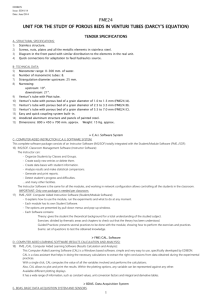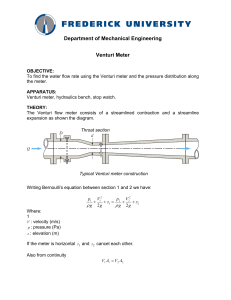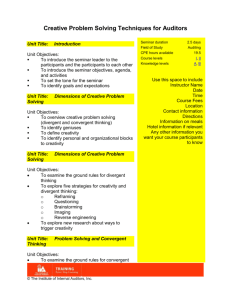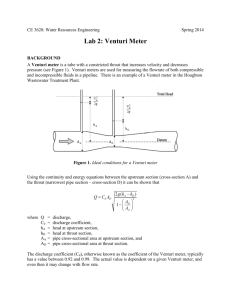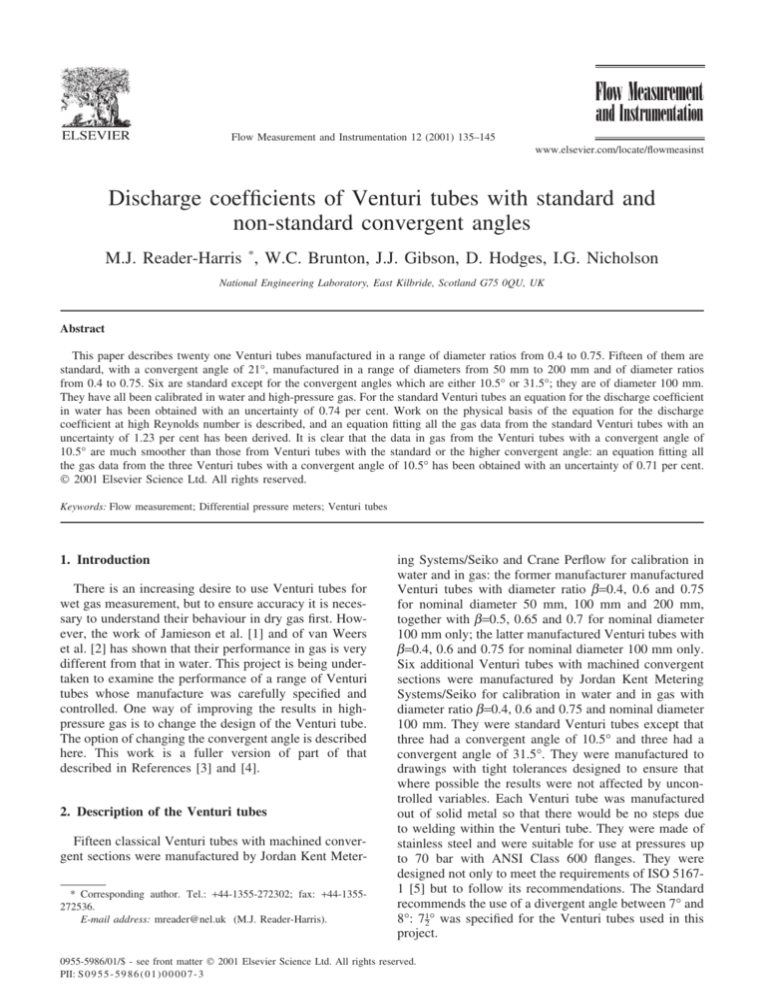
Flow Measurement and Instrumentation 12 (2001) 135–145
www.elsevier.com/locate/flowmeasinst
Discharge coefficients of Venturi tubes with standard and
non-standard convergent angles
M.J. Reader-Harris *, W.C. Brunton, J.J. Gibson, D. Hodges, I.G. Nicholson
National Engineering Laboratory, East Kilbride, Scotland G75 0QU, UK
Abstract
This paper describes twenty one Venturi tubes manufactured in a range of diameter ratios from 0.4 to 0.75. Fifteen of them are
standard, with a convergent angle of 21°, manufactured in a range of diameters from 50 mm to 200 mm and of diameter ratios
from 0.4 to 0.75. Six are standard except for the convergent angles which are either 10.5° or 31.5°; they are of diameter 100 mm.
They have all been calibrated in water and high-pressure gas. For the standard Venturi tubes an equation for the discharge coefficient
in water has been obtained with an uncertainty of 0.74 per cent. Work on the physical basis of the equation for the discharge
coefficient at high Reynolds number is described, and an equation fitting all the gas data from the standard Venturi tubes with an
uncertainty of 1.23 per cent has been derived. It is clear that the data in gas from the Venturi tubes with a convergent angle of
10.5° are much smoother than those from Venturi tubes with the standard or the higher convergent angle: an equation fitting all
the gas data from the three Venturi tubes with a convergent angle of 10.5° has been obtained with an uncertainty of 0.71 per cent.
2001 Elsevier Science Ltd. All rights reserved.
Keywords: Flow measurement; Differential pressure meters; Venturi tubes
1. Introduction
There is an increasing desire to use Venturi tubes for
wet gas measurement, but to ensure accuracy it is necessary to understand their behaviour in dry gas first. However, the work of Jamieson et al. [1] and of van Weers
et al. [2] has shown that their performance in gas is very
different from that in water. This project is being undertaken to examine the performance of a range of Venturi
tubes whose manufacture was carefully specified and
controlled. One way of improving the results in highpressure gas is to change the design of the Venturi tube.
The option of changing the convergent angle is described
here. This work is a fuller version of part of that
described in References [3] and [4].
2. Description of the Venturi tubes
Fifteen classical Venturi tubes with machined convergent sections were manufactured by Jordan Kent Meter* Corresponding author. Tel.: +44-1355-272302; fax: +44-1355272536.
E-mail address: mreader@nel.uk (M.J. Reader-Harris).
ing Systems/Seiko and Crane Perflow for calibration in
water and in gas: the former manufacturer manufactured
Venturi tubes with diameter ratio b=0.4, 0.6 and 0.75
for nominal diameter 50 mm, 100 mm and 200 mm,
together with b=0.5, 0.65 and 0.7 for nominal diameter
100 mm only; the latter manufactured Venturi tubes with
b=0.4, 0.6 and 0.75 for nominal diameter 100 mm only.
Six additional Venturi tubes with machined convergent
sections were manufactured by Jordan Kent Metering
Systems/Seiko for calibration in water and in gas with
diameter ratio b=0.4, 0.6 and 0.75 and nominal diameter
100 mm. They were standard Venturi tubes except that
three had a convergent angle of 10.5° and three had a
convergent angle of 31.5°. They were manufactured to
drawings with tight tolerances designed to ensure that
where possible the results were not affected by uncontrolled variables. Each Venturi tube was manufactured
out of solid metal so that there would be no steps due
to welding within the Venturi tube. They were made of
stainless steel and were suitable for use at pressures up
to 70 bar with ANSI Class 600 flanges. They were
designed not only to meet the requirements of ISO 51671 [5] but to follow its recommendations. The Standard
recommends the use of a divergent angle between 7° and
8°: 712° was specified for the Venturi tubes used in this
project.
0955-5986/01/$ - see front matter 2001 Elsevier Science Ltd. All rights reserved.
PII: S 0 9 5 5 - 5 9 8 6 ( 0 1 ) 0 0 0 0 7 - 3
136
M.J. Reader-Harris et al. / Flow Measurement and Instrumentation 12 (2001) 135–145
Nomenclature
C
Cwater
D
d
dtap
e
k
Ra
ReD
Red
Retap
Re*
ū
ut
b
l
n
r
t
Discharge coefficient
Mean discharge coefficient in water
Diameter of entrance cylinder, m
Throat diameter, m
Tapping hole diameter, m
Change in measured pressure, Pa
Uniform equivalent roughness (as on the Moody diagram), m
Arithmetic mean deviation of the roughness profile, m
Pipe Reynolds number
Throat Reynolds number
Tapping hole Reynolds number (=utdtap/n)
Venturi throat tapping Reynolds number (=Reddtap/d)
Mean velocity, m/s
Friction velocity (=√(t/r)), m/s
Diameter ratio (=d/D)
Friction factor
Kinematic viscosity, m2/s
Density, kg/m3
Wall shear stress, Pa
So that the results would not be corrupted by the introduction of steps at joins in the pipework, an upstream
length of 8D (6D for 200 mm pipe) and a downstream
length of 4D, where D is the diameter of the entrance
cylinder, were manufactured with machined bores; this
ensured that in no case was there a step in diameter
greater than 0.0035D at the upstream flange of the Venturi tube. The lengths of pipework were manufactured
by boring out Schedule 80 pipe to the bore of a Schedule
40 pipe. The lengths of pipe and the Venturi tubes were
dowelled to ensure concentricity; O rings were used to
ensure that there would not be recesses or protruding
gaskets. The distance from the upstream pressure tappings to the first upstream flange was 1.5D, 1.1D and
0.7D for nominal diameters of 50 mm, 100 mm and 200
mm respectively.
In addition to the shorter lengths of pipework already
described, an additional 21D (23D of 200 mm pipe)
length was manufactured by welding a 19D (21D of 200
mm pipe) length of Schedule 40 pipe to a 2D length of
pipe machined to the bore of the other pipes, smoothing
off any step at the weld. This length of pipe was installed
with the machined length adjacent to the machined pipe
already described, so that there was at least 8D of
machined pipework, whose bore matched that of the
Venturi tube very accurately, immediately upstream of
the Venturi tube. In total there was 29D of pipe of the
same schedule with no recesses, protruding gaskets or
significant steps upstream of the Venturi tube. Upstream
of this assembly there was generally further pipe of the
same nominal diameter preceded by a flow conditioner.
The Standard recommends that the radii of curvature
at the intersections of the entrance cylinder and the convergent section, the convergent section and the throat,
and the throat and the divergent section be equal to zero,
although significantly larger values are permitted. The
drawings requested a maximum radius of curvature of 1
mm. In order to measure the radius of curvature,
measurements of profile were made through the convergent and the throat with one trace per Venturi tube. This
was not possible for some of the Venturi tubes. The average of the measured radii of curvature was 15 mm. Some
radii of curvature were outside the permitted value of
0.25d, but the range of radii of curvature does not appear
to be the cause of the spread in measured discharge coefficients.
The Standard requires that the surface finish of the
entrance cylinder, the convergent section and the throat
be such that Ra/d shall always be less than 10⫺5, where
Ra is the arithmetical mean deviation of the roughness
profile. However, this was typically exceeded by a factor
of approximately 3; the typical surface finish was Ra⬇2
µm. All the Venturi tubes had 10⫺5⬍Ra/d⬍10⫺4. If the
Draft International Standard proposed to replace ISO
5167-1 is accepted the maximum permissible roughness
will be increased so that Ra/d shall be less than 10⫺4.
The project wished to use Venturi tubes with surface
roughnesses typical of those used in the field. Moreover,
the range of roughnesses does not appear to be the cause
of the spread in measured discharge coefficients.
Except for the Venturi tube with a throat diameter of
20 mm the pressure tappings were 4 mm in diameter;
the throat pressure tappings were of constant diameter
for a length of 94 mm and the upstream tappings for a
M.J. Reader-Harris et al. / Flow Measurement and Instrumentation 12 (2001) 135–145
length of 53 mm. The Venturi tube with a throat diameter of 20 mm had pressure tappings of diameter 2.6
mm; the throat pressure tappings were of constant diameter for a length of 62 mm and the upstream tappings
for a length of 37 mm. Tappings of constant diameter
were used because the work described by Jamieson et
al. [1] suggested that they might be beneficial. The tappings were connected in “triple-tee” arrangements.
For most of the Venturi tubes the convergent angles
were determined both from three measurements of diameter for each convergent cone and from the wall profile
measurements from which the intersection radii were
obtained. The measured value of the convergent angle
never differed from the nominal value by more than
0.14°.
Except for one measured diameter in the 20 mm throat
(nominal diameter 50 mm, b=0.4), the measured throat
diameters were within 0.1 per cent of the mean value of
the throat diameters at the pressure tappings. The measured diameters of the entrance cylinders were within
0.075 per cent of the mean value of the entrance cylinder
diameters at the pressure tappings.
3. Calibration in water
137
for 1.2×105⬍ReD⬍2×105; the throat Reynolds number
below which C decreased rapidly varied but was typically about 2.5×105.
Fitting the data in Fig. 1 gives an equation for C in
water of
Cwater⫽0.9878⫹0.0123b.
(1)
This equation has an uncertainty (based on two standard
deviations) of 0.74 per cent.
The data from the non-standard Venturi tubes are
shown in Fig. 2. For comparison Eq. (1) is shown. The
discharge coefficients of the Venturi tubes with a convergent angle of 10.5° are smaller than those with the standard angle owing to the additional pressure loss in the
longer throat. The discharge coefficients of the Venturi
tubes with a convergent angle of 31.5° are also smaller
than those with the standard angle. This may be due to
separation at the downstream end of the convergent section.
The non-standard Venturi tubes together with five
with standard convergent angles were calibrated in water
both in the NEL Water Bay and in the NEL Multiphase
Flow Facility. The two Venturi tubes with convergent
angle 31.5° and diameter ratios 0.6 and 0.75 gave results
significantly different from the pattern of results taken
with the other nine Venturi tubes. They have discharge
coefficients which are higher in the Multiphase Flow
Facility than in the Water Bay. Perhaps for some reason
the flow separated in the throat of the Venturi tube in
the Water Bay but not in the Multiphase Flow Facility.
Perhaps Venturi tubes with convergent angles significantly larger than the standard value give less repeatable
results than ones with the standard convergent angle.
The Venturi tubes were calibrated in water in the
UKAS-accredited National Standard facility for water
flow measurement. For each Venturi tube the data in
water lay on a straight line and with a small scatter. The
gradients were small: when fitted against ReD the
majority had a positive gradient but since several had a
negative gradient it seemed appropriate to represent the
discharge coefficient of each Venturi tube by its mean
value. Over the range of the data the average increase
in discharge coefficient with Reynolds number was
0.0007. The results for the standard Venturi tubes are
shown in Fig. 1. Where two Venturi tubes are made from
the same drawings the maximum difference in mean discharge coefficient is 0.57 per cent. The Reynolds number
range over which the data were used to calculate the
mean was that over which C was approximately constant. In one case there was a significant hump in the data
The Venturi tubes were calibrated in gas in the
UKAS-accredited National Standard facility for highpressure gas flow measurement at two static pressures,
20 bar and 60 (or 70) bar, and the data from those with
the standard convergent angle are presented in Figs. 3–
Fig. 1.
angle.
Fig. 2. Mean discharge coefficients in water: non-standard convergent angles.
Mean discharge coefficients in water: standard convergent
4. Calibration in gas
138
M.J. Reader-Harris et al. / Flow Measurement and Instrumentation 12 (2001) 135–145
6. All the gas data were collected in air except the data
for 100 mm for b=0.4 from Jordan Kent Metering
Systems/Seiko, which were collected in nitrogen. Since
there are two 100 mm Venturi tubes for b=0.4, 0.6 and
0.75, the ones from Jordan Kent Metering Systems/Seiko
are described as “100 mm” and those from Crane Perflow are described as “100 mm*”. In Fig. 5(a) and (b)
“Yokogawa DP” and “Mensor DP” refer to the devices
used to measure the differential pressure; they were used
for two separate calibrations. The data collected in gas
are more scattered than those taken in water. There are
peaks and troughs in the data sets. In general better
agreement is obtained between the two sets of data
obtained at different static pressures when the data are
fitted against Reynolds number; however, it is clear that
the location of the peaks and troughs is a function of the
throat velocity. This can be seen in Figs. 3–6, or more
clearly, since there are fewer points, in Figs. 7–9. The
points for which ⌬p/p1⬎0.08 were omitted from the
curve fitting in this paper since these points displayed a
reduction in discharge coefficient from what would have
been expected from other data from the same Venturi
Fig. 4. (a) Calibration in gas against Reynolds number: b=0.5, 0.65
and 0.7, standard convergent angle; (b) Calibration in gas against throat
velocity: b=0. 5, 0.65 and 0.7, standard convergent angle.
tube. It is assumed that this effect is due to expansibility
effects which are not incorporated in the expansibility
equation. The difference is, however, less than the predicted uncertainty of e1 in ISO 5167-1.
The data for non-standard convergent angles are
presented in Figs. 7–9. The peaks and troughs are larger
in the data for a convergent angle of 31.5° than in those
for one of 10.5°. In the former case there are throat velocities near which the discharge coefficient changes rapidly.
5. Static hole error
Fig. 3. (a) Calibration in gas against Reynolds number: b=0.4, standard convergent angle; (b) Calibration in gas against throat velocity:
b=0.4, standard convergent angle.
In order to fit the gas data it is helpful to observe that
some of the variation in C can be removed by examining
C⫺Cwater where Cwater is the mean value for the water
data for that Venturi tube as shown in Fig. 1 or 2. A
possible cause for the change in discharge coefficient
from that obtained in water is static hole error. Static
hole error is the effect that pressure tappings of finite
size do not measure the pressure which would have been
M.J. Reader-Harris et al. / Flow Measurement and Instrumentation 12 (2001) 135–145
Fig. 5. (a) Calibration in gas against Reynolds number: b=0.6, standard convergent angle; (b) Calibration in gas against throat velocity:
b=0.6, standard convergent angle.
measured using an infinitely small hole. The effect of
static hole error is that the measured pressure using a
pressure tapping is higher than the static pressure would
have been if the tapping had not been present. This effect
is considered in many papers (e.g. Franklin and Wallace
[6] and Gibson et al. [7]). If the increase in measured
pressure is denoted by e and the wall shear stress by
t, then
e
⫽f(Retap),
t
(2)
where Retap is the tapping hole Reynolds number
defined by
utdtap
,
Retap⫽
n
(3)
dtap is the tapping diameter, n is the kinematic viscosity,
ut is the friction velocity, √(t/r), and r is the density.
Because the velocity and therefore the wall shear stress
are much higher in the throat than in the entrance cylinder, the static hole error leads to a reduction in the meas-
139
Fig. 6. (a) Calibration in gas against Reynolds number: b=0.75, standard convergent angle; (b) Calibration in gas against throat velocity:
b=0.75, standard convergent angle.
ured differential pressure and an increase in the measured value of C. To calculate the static hole error it is
necessary to have an estimate of the relationship between
t and ū, the mean velocity at the tapping plane. Following Schlichting [8], this is expressed in terms of the friction factor, l, where
t⫽18lrū2.
(4)
In a standard Venturi tube, in both tapping planes
Lindley [9] made measurements of t from which l can
be deduced. Lindley showed that in the entrance cylinder
l appears to be becoming asymptotic to 0.012 as Reynolds number increases. For 106⬍ReD⬍107 and
k/D=5×10⫺5, l will always be within 10 per cent of
0.012 in a straight pipe according to the Moody Diagram
(see Schlichting); so it seems an appropriate value to
use. In the throat, Lindley’s measurements of l are
approximately 18 per cent higher than would be obtained
in a straight pipe of the same relative roughness and
Reynolds number; so in determining the static hole error
a figure of 0.015 has been used (for 106⬍Red and
140
M.J. Reader-Harris et al. / Flow Measurement and Instrumentation 12 (2001) 135–145
Fig. 7. (a) Calibration in gas against Reynolds number: b=0.4, 100
mm, non-standard convergent angles; (b) Calibration in gas against
throat velocity: b=0.4, 100 mm, non-standard convergent angles.
k/d=10⫺4, 1.18l will always be within 6 per cent of
0.015 according to the Moody Diagram).
On this basis (and assuming incompressible flow) the
predicted value of the total reduction in differential
pressure, etotal, is given by
etotal⫽ ū
1 2
8 throat
4
r(0.015f(Retap,throat)⫺0.012b f(Retap,up)), (5)
Fig. 8. (a) Calibration in gas against Reynolds number: b=0.6, 100
mm, non-standard convergent angles; (b) Calibration in gas against
throat velocity: b=0.6, 100 mm, non-standard convergent angles.
f ∗(Retap)⫽a(e−nRetap⫺e−3000n) for Retap⬎3000
the measured values of C⫺Cwater can be fitted, and the
best fit of f* to the gas data is
f ∗(Retap)
再
⫽
This corresponds to an increase in discharge coefficient of approximately
0.015f(Retap,throat)−0.012b4f(Retap,up)
8(1−b4)
(6)
In deriving an equation it is necessary to consider the
change in C from that found in water. Towards the
higher end of the Reynolds number range of a calibration
in water a typical value of Retap,throat is 3000 at which f
is approximately equal to 3.8; so f(Retap) is written as
f*(Retap) +3.8 where f*(3000) is equal to 0. In water
Retap,up will be less than 3000, but the coefficient of f
will be larger than 0.012. Assuming that
(7)
(8)
7.165−8.839e−0.00007Retap for Retap⬎3000
0 for Retapⱕ3000.
This fit has an uncertainty based on two standard deviations of 0.0074. The true static hole error (rather than
the difference between the static hole error in high-pressure gas and that in water) is based on
f(Retap)⫽10.965⫺8.839e−0.00007Retap for Retap⬎3000
(9)
and is shown in Fig. 10. Moreover, when the uncertainty
of the complete equation (from Eqs. (1) and (6))
C⫽0.9878⫹0.0123b
0.015f ∗(Retap,throat)−0.012b4f ∗(Retap,up)
⫹
8(1−b4)
(10)
M.J. Reader-Harris et al. / Flow Measurement and Instrumentation 12 (2001) 135–145
141
with f *(Retap) given by Eq. (8) is considered, the uncertainty (based on two standard deviations) of the complete
database of values of C in gas is 1.24 per cent.
Similarly for a convergent angle of 10.5° the best fit
of f * to the gas data gives
f ∗(Retap)
再
⫽
(11)
5.229−5.896e
for Retap⬎3000
0
for Retapⱕ3000.
−0.00004Retap
This fit has an uncertainty based on two standard deviations of 0.0056. The true static hole error (rather than
the difference between the static hole error in high-pressure gas and that in water) is based on
f(Retap)⫽9.029⫺5.896e−0.00004Retap for Retap⬎3000
(12)
and is shown in Fig. 10. When the uncertainty of the
complete equation
C⫽0.9677⫹0.219b
(13)
0.015f ∗(Retap,throat)−0.012b4f ∗(Retap,up)
⫹
8(1−b4)
Fig. 9. (a) Calibration in gas against Reynolds number: b=0.75, 100
mm, non-standard convergent angles; (b) Calibration in gas against
throat velocity: b=0.75, 100 mm, non-standard convergent angles.
Fig. 10.
with f *(Retap) given by Eq. (11) is considered, the uncertainty (based on two standard deviations) of the complete
database of values of C in gas is 0.76 per cent. This
equation is based on the best fit to the mean discharge
coefficients in water for a convergent angle of 10.5°
(three points shown in Fig. 2) together with Eq. (6). This
uncertainty is much lower than that obtained with the
standard convergent angle, but is based on data from
only three Venturi tubes.
For a convergent angle of 31.5° the best fit of f * to
the gas data gives
Static hole error.
142
M.J. Reader-Harris et al. / Flow Measurement and Instrumentation 12 (2001) 135–145
f ∗(Retap)
⫽
(14)
再
9.879−11.138e
0.00004Retap
for Retap⬎3000
for Retapⱕ3000.
0
This fit has an uncertainty based on two standard deviations of 0.0130. The true static hole error (rather than
the difference between the static hole error in high-pressure gas and that in water) is based on
that the upstream static hole error term is much smaller
than the throat term and that therefore it is possible simply to correlate the data with the throat tapping Reynolds
number; the simplest presentation of this is to define the
Venturi throat tapping Reynolds number
Re∗⫽
dtap
Re .
d d
(17)
and is shown in Fig. 10. When the uncertainty of the
complete equation
The data for C⫺Cwater can then be plotted against Re*,
and Figs. 11–13 give the gas data for the standard convergent angle and for convergent angles of 10.5° and
31.5° respectively. Fitting the gas data for the standard
convergent angle for C⫺Cwater gives:
C⫽1.0189⫺0.0619b
C⫺Cwater
f(Retap)⫽13.679⫺11.138e−0.00004Retap for Retap⬎3000 (15)
∗
(16)
再
4 ∗
0.015f (Retap,throat)−0.012b f (Retap,up)
⫹
8(1−b4)
with f *(Retap) given by Eq. (14) is considered, the uncertainty (based on two standard deviations) of the complete
database of values of C in gas is 1.47 per cent. This
equation is based on the best fit to the mean discharge
coefficients in water for a convergent angle of 31.5°
(three points shown in Fig. 2) together with Eq. (6).
None of the equations from Venturi tubes of different
convergent angles is inconsistent with the data in Fig.
10 (see [7] for the CFD and [10–13] for the other data;
the CFD results from many analyses have been represented by curve fits, as the sets of results were in good
agreement with one another). This is encouraging in that
there is a physical explanation for the discharge coefficient values measured in gas. Results at high Reynolds
numbers, however, depend on other parameters besides
Retap. This can be seen not only in the work done for
this paper but also in the other experimental results,
which are very varied at high Reynolds numbers,
whereas (see [7]) good agreement between experimental
data has been achieved at the Reynolds numbers
obtained in water. Moreover, the cause of the peaks and
troughs in the data is not clear: they may be the result
of unsteady effects (e.g. acoustic effects), whereas the
basic static hole error is a steady effect. These unsteady
effects may lead not only to peaks and troughs, but also
to a change in the static hole error from its basic value.
The agreement between the CFD with the RSM turbulence model and Eq. (12), which is based on data with
small peaks and troughs, suggests that for Venturi tubes
with a convergent angle of 10.5° the basic static hole
error model may be a very good model of the data in gas.
6. Practical equations
An alternative method of presenting the data which is
easier to use than the method in Section 5 is to observe
⫽
(18)
−0.4(Re∗/105)
0.0133−0.0169e
Re ⬎60000
0
Re∗ⱕ60000
∗
This is shown in Fig. 11. It has an uncertainty (based
on two standard deviations) of 0.0074. When the corresponding overall equation
C⫽
(19)
再
1.0011+0.0123b−0.0169e
−0.4(Re∗/105)
Re∗⬎60000
Re∗ⱕ60000
0.9878+0.0123b
is compared with the database for C obtained in gas, it
has an uncertainty (based on two standard deviations) of
1.23 per cent.
For a convergent angle of 10.5° fitting the gas data
for C⫺Cwater gives
(20)
C⫺Cwater
再
⫽
−0.4(Re∗/105)
0.0085−0.0148e
Re∗⬎140000
0
Re∗ⱕ140000
This is shown in Fig. 12. It has an uncertainty (based
on two standard deviations) of 0.0047. When the corresponding overall equation
C⫽
再
0.9762+0.0219b−0.0148e
0.9677+0.0219b
(21)
−0.4(Re∗/105)
Re∗⬎140000
Re∗ⱕ140000
is compared with the data for C obtained in gas, it has
an uncertainty (based on two standard deviations) of
0.71 per cent. This figure is much lower than that
obtained for Venturi tubes of standard convergent angle.
It is necessary to establish that Eq. (21) is applicable for
general use by undertaking further test work, since it is
based on only three Venturi tubes. The standard deviation of the fit to the mean data for a convergent angle
of 10.5° in water is 0.42 per cent.
M.J. Reader-Harris et al. / Flow Measurement and Instrumentation 12 (2001) 135–145
Fig. 11.
C⫺Cwater with standard convergent angle.
Fig. 12.
C⫺Cwater with 10.5° convergent angle.
For a convergent angle of 31.5° fitting the gas data
for C⫺Cwater gives
C⫺Cwater
⫽
再
(22)
∗/105)
143
0.0161−0.0281e−0.4(Re
Re∗⬎140000
0
Re∗ⱕ140000
This is shown in Fig. 13. It has an uncertainty (based
on two standard deviations) of 0.0102. This is more than
twice the value for the Venturi tubes with 10.5° convergent angle.
When the corresponding overall equation
C⫽
再
1.0350−0.0619b−0.0281e
1.0189−0.0619b
(23)
−0.4(Re∗/105)
Re∗⬎140000
Re∗ⱕ140000
is compared with the data for C obtained in gas, it has
an uncertainty (based on two standard deviations) of
1.36 per cent. The standard deviation of the fit to the
mean data for a convergent angle of 31.5° in water is
0.79 per cent.
144
M.J. Reader-Harris et al. / Flow Measurement and Instrumentation 12 (2001) 135–145
Fig. 13.
C⫺Cwater with 31.5° convergent angle.
7. Conclusions
Twenty one Venturi tubes of a wide variety of diameters and diameter ratios have been made and calibrated
in water and high-pressure gas. Fifteen of these are of
the standard design, and an equation for the discharge
coefficient in water has been obtained with an uncertainty of 0.74 per cent. This uncertainty is derived from
the mean values of discharge coefficient for each Venturi
tube and is based on 2 standard deviations of these mean
values about the equation. In gas the situation is considerably more complicated. The recommended equation
is Eq. (19) with Re* defined in Eq. (17). This has an
uncertainty of 1.23 per cent. The physical basis of this
equation is static hole error theory. This provides a partial explanation of the measured discharge coefficients.
Given the problems with the use of Venturi tubes in gas
found in earlier work, this uncertainty is considered to
be good.
The effect of changing the convergent angle of the
Venturi tubes has been investigated and most encouraging results obtained with a convergent angle of 10.5°;
indeed the gas data from the three Venturi tubes can be
fitted with an uncertainty of 0.71 per cent by Eq. (21),
which both has a physical basis and gives optimum
results in water. This equation for Venturi tubes with a
convergent angle of 10.5° is only based on three Venturi
tubes; so further work in this area is desirable.
Further work on the effect of Venturi shape and of
tapping diameter is being undertaken.
Acknowledgements
The work described in this paper was carried out as
part of the Flow Programme, under the sponsorship of
the National Measurement System Policy Unit of the
United Kingdom Department of Trade and Industry.
Their support is gratefully acknowledged.
This paper is published by permission of the Director, NEL.
References
[1] A.W. Jamieson, P.A. Johnson, E.P. Spearman, J. Sattary, Unpredicted behaviour of Venturi flowmeter in gas at high Reynolds
numbers. In Proc. 14th North Sea Flow Measurement Workshop,
Peebles, Scotland, 1996, paper 5.
[2] T. Van Weers, M.P. van der Beek, I.J. Landheer, Cd-factor of
classical Venturi’s: gaming technology? In Proc. 9th Int. Conf.
on Flow Measurement, FLOMEKO, Lund, Sweden, 1998, pp.
203–207.
[3] M.J. Reader-Harris, W.C. Brunton, J.J. Gibson, D. Hodges, I.G.
Nicholson, Venturi tube discharge coefficients. In Proc. 4th Int.
Symposium on Fluid Flow Measurement, Denver, Colorado,
1999.
[4] M.J. Reader-Harris, W.C. Brunton, J.J. Gibson, D. Hodges, Discharge coefficients of Venturi tubes with non-standard convergent
angles. In Proc. FLOMEKO 2000, Salvador, Brazil, 2000.
[5] International Organization for Standardization. Measurement of
fluid flow by means of orifice plates, nozzles and Venturi tubes
inserted in circular cross-section conduits running full. ISO 51671, Geneva: International Organization for Standardization, 1991.
[6] R.E. Franklin, J.M. Wallace, Absolute measurements of statichole error using flush mounted transducers, J. Fluid Mech. 42 (1)
(1970) 33–48.
[7] J.J. Gibson, M.J. Reader-Harris, A. Gilchrist, CFD analysis of the
static hole error caused by tappings in Venturimeters operating in
high-pressure gas. In Proc. 3rd ASME/JSME Joint Fluids Engineering Conference, San Francisco, FEDSM99-7149, 1999. New
York: American Society of Mechanical Engineers.
[8] H. Schlichting, Boundary Layer Theory, McGraw-Hill, New
York, 1960.
[9] D. Lindley, Venturimeters and boundary layer effects. PhD Thesis, Cardiff: Dept. of Mech. Eng., Univ. Coll. of South Wales
and Monmouthshire, 1966.
[10] R.D. Flack, Jr. An experimental investigation of static pressure
hole errors in transonic flow with pressure gradients. In Proc.
Southeast Sem. on Thermal Science, 1978, pp. 364–378.
M.J. Reader-Harris et al. / Flow Measurement and Instrumentation 12 (2001) 135–145
[11] T.H. Moulden, F.G. Wu, H.J. Collins, H. Ramm, C.I. Wu, R.
Ray, Experimental study of static pressure orifice interference.
AEDC TR-77-57, 1977.
[12] E.B. Plentovich, B.B. Gloss, Orifice-induced pressure error studies in Langley 7 by 10 foot high-speed tunnel. NASA Tech. Paper
2545, 1986.
145
[13] W.J. Rainbird, Errors in measurement of mean static pressure of
a moving fluid due to pressure holes. Quart. Bull. Div. Mech.
Eng., Nat. Res. Council, Canada, Rep. DME/NAE. No. 3, 1967.



